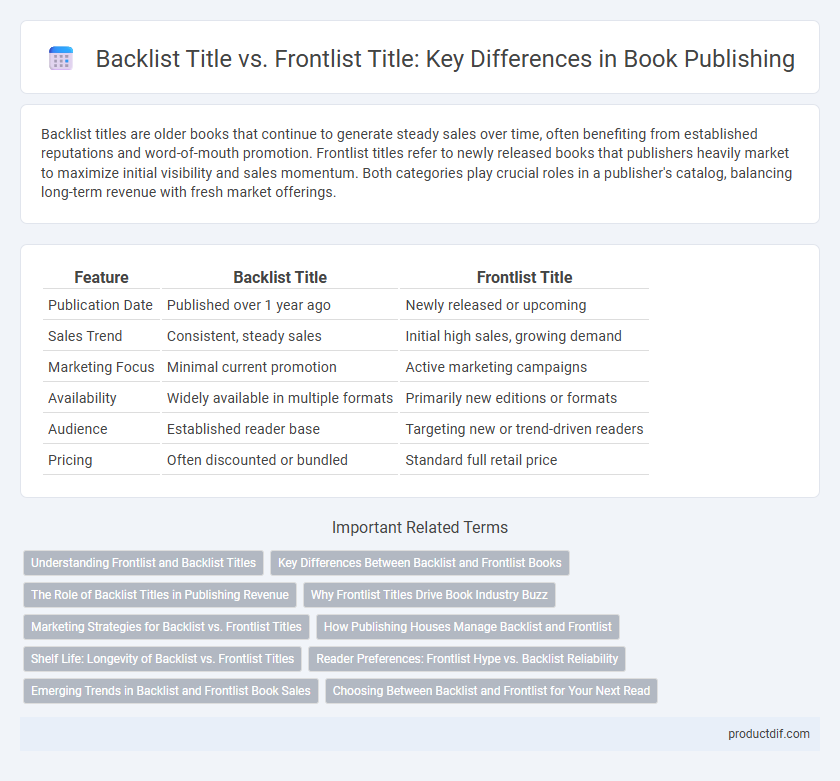Backlist titles are older books that continue to generate steady sales over time, often benefiting from established reputations and word-of-mouth promotion. Frontlist titles refer to newly released books that publishers heavily market to maximize initial visibility and sales momentum. Both categories play crucial roles in a publisher's catalog, balancing long-term revenue with fresh market offerings.
Table of Comparison
| Feature | Backlist Title | Frontlist Title |
|---|---|---|
| Publication Date | Published over 1 year ago | Newly released or upcoming |
| Sales Trend | Consistent, steady sales | Initial high sales, growing demand |
| Marketing Focus | Minimal current promotion | Active marketing campaigns |
| Availability | Widely available in multiple formats | Primarily new editions or formats |
| Audience | Established reader base | Targeting new or trend-driven readers |
| Pricing | Often discounted or bundled | Standard full retail price |
Understanding Frontlist and Backlist Titles
Frontlist titles refer to newly released books actively promoted by publishers to generate immediate sales and visibility. Backlist titles encompass previously published books that continue to generate steady revenue and maintain readership over time. Understanding the distinction between frontlist and backlist titles helps authors, publishers, and booksellers optimize marketing strategies and inventory management.
Key Differences Between Backlist and Frontlist Books
Backlist titles refer to older books that have been published for more than six months and typically generate steady, long-term sales, while frontlist titles are new releases actively promoted by publishers for immediate visibility and sales impact. Publishers allocate marketing resources primarily to frontlist books to maximize initial sales, whereas backlist titles rely on accumulated word-of-mouth and established readership. The distinction affects inventory management, with frontlist inventory subject to frequent updates and backlist titles maintained for ongoing availability.
The Role of Backlist Titles in Publishing Revenue
Backlist titles, often overlooked in favor of new frontlist releases, generate steady and substantial revenue streams for publishers by maintaining consistent sales long after initial publication. These established books benefit from accumulated market presence, reader loyalty, and ongoing demand, contributing significantly to a publisher's long-term financial stability. Effective backlist management, including strategic rebranding and digital availability, maximizes profitability by capitalizing on evergreen content.
Why Frontlist Titles Drive Book Industry Buzz
Frontlist titles generate significant buzz in the book industry due to their novelty and marketing focus, attracting media attention and consumer interest. These new releases often receive extensive promotional campaigns, including author tours, reviews, and conspicuous placement in bookstores, which amplify their visibility and sales potential. In contrast, backlist titles represent established works with steady, long-term sales but typically lack the surge of excitement and promotional investment associated with frontlist offerings.
Marketing Strategies for Backlist vs. Frontlist Titles
Backlist titles require marketing strategies that leverage established reader trust and focus on long-term sales through targeted promotions, email campaigns, and use of social media algorithms to maintain visibility. Frontlist titles benefit from intensive launch campaigns including book tours, influencer partnerships, and timed advertising to generate immediate buzz and spike initial sales. Effective differentiation in marketing efforts optimizes revenue by aligning promotional tactics with each title's market lifecycle and audience engagement patterns.
How Publishing Houses Manage Backlist and Frontlist
Publishing houses strategically manage backlist titles by leveraging their established sales data and consistent demand to generate steady revenue with minimal marketing costs. Frontlist titles receive focused promotion and investment to build initial visibility and maximize launch sales, often involving coordinated marketing campaigns, author events, and retail partnerships. Efficient inventory and rights management ensure that backlist titles remain available while frontlist titles drive immediate market impact and brand growth.
Shelf Life: Longevity of Backlist vs. Frontlist Titles
Backlist titles generally enjoy a longer shelf life compared to frontlist titles due to their established reputation, consistent demand, and ongoing discovery by new readers. Frontlist titles often experience a concentrated sales period surrounding their release, driven by marketing and initial buzz, but may see a rapid decline in visibility afterward. The enduring availability of backlist titles supports steady revenue streams for publishers and authors well beyond the typical lifespan of frontlist books.
Reader Preferences: Frontlist Hype vs. Backlist Reliability
Readers often gravitate toward frontlist titles due to current hype, marketing campaigns, and media buzz that promise fresh and trending narratives. In contrast, backlist titles offer established reliability, with proven literary quality and consistent reader satisfaction over time. This dynamic influences purchasing decisions, as some readers seek novelty and others prioritize trusted, enduring stories.
Emerging Trends in Backlist and Frontlist Book Sales
Backlist titles, often older publications, demonstrate steady sales driven by sustained reader interest and renewed marketing strategies, while frontlist titles, representing new releases, capture market attention through initial publicity and author events. Emerging trends reveal an increasing reliance on backlist titles for consistent revenue, fueled by digital platforms and subscription services that boost discoverability. Simultaneously, frontlist titles benefit from targeted social media campaigns and influencer partnerships that accelerate early sales momentum.
Choosing Between Backlist and Frontlist for Your Next Read
Choosing between a backlist title and a frontlist title depends on your reading preferences and timing; backlist books, often established classics or hidden gems, provide proven quality and enduring appeal. Frontlist titles are newly released works that offer the latest trends and contemporary voices in literature. Selecting a backlist title guarantees a vetted reading experience, while a frontlist title introduces fresh narratives and the excitement of discovery.
Backlist Title vs Frontlist Title Infographic

 productdif.com
productdif.com